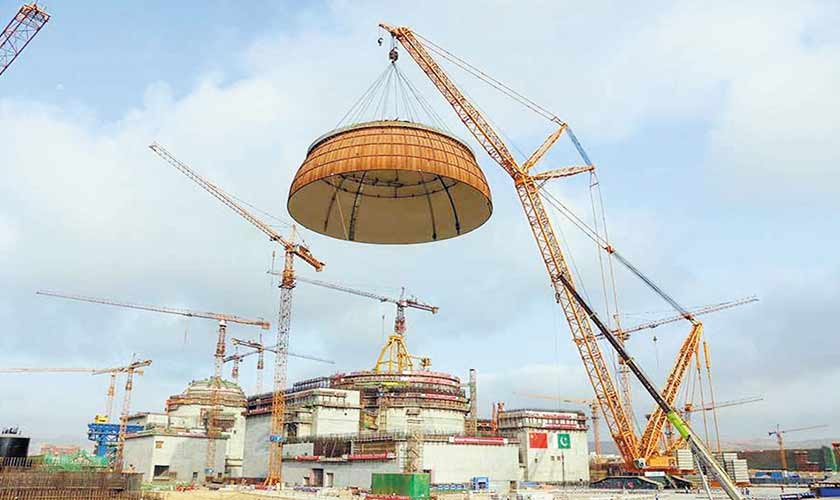Going carbon free
By
Engr. Hussain Ahmad Siddiqui
Mon, 12, 20
The commencement of commercial operations next year of the state-of-the-art Karachi Nuclear Power Plant of 1,145MWe (megawatts electric) installed capacity will usher in a new era of national energy security and economic progress. National Electric Power Regulatory Authority (NEPRA) has already issued license, on December 9, 2019, to the under-construction project, commonly known as KANUPP-2 or K-2.
The commencement of commercial operations next year of the state-of-the-art Karachi Nuclear Power Plant of 1,145MWe (megawatts electric) installed capacity will usher in a new era of national energy security and economic progress. National Electric Power Regulatory Authority (NEPRA) has already issued license, on December 9, 2019, to the under-construction project, commonly known as KANUPP-2 or K-2.
Pakistan began operating its first commercial nuclear power plant in 1971-72. It was established in the coastal area of Karachi under the economic and technical assistance of Canada, now termed as KANUPP-1 or K-1. A pressurised heavy water reactor (PHWR) type, originally of 137MWe installed capacity, it has outlived design lifetime long ago. The plant, still in operation, has been de-rated at 90MWe net capacity. Preparations are in hand for the decommissioning of K-1 at the time when the two under-construction nuclear power plants at Karachi will be completed to commence commercial production.
Due to international pressures and other constraints, it would not be possible for Pakistan, being outside the UN’s Nuclear Non-Proliferation Treaty (NPT), to implement its plan for enhancing nuclear power generation capacity in subsequent years. It was only after China came to support us in this strategic field, which was after more than three decades of KANUPP-1 operations. Thus, the second commercial nuclear power plant was commissioned and grid-connected in the year 2000.
Now known as Chashma Nuclear Power Plant-1 (or CHASNUPP-1 or C-1), it has PWR (pressurised water reactor) type reactor of 325MWe gross or 300MWe net capacity. Since then, there has been a series of nuclear power plants constructed at Chashma site with the generous help of China. These are CHASNUPP-2 (or C-2) of 325MWe gross or 300MWe net capacity, grid-connected in 2011, CHASNUPP-3 (or C-3) of 340MWe gross or 315MWe net capacity, grid-connected in 2016, and CHASNUPP-4 (C-4) of 340MWe or 313MWe net capacity, which was grid connected in 2017.
Today, cumulative capacity of these nuclear power plants is 1,467MWe gross or 1,318MWe net, generating 9,705GWh (Gigawatt-hours) with a share of over seven percent in power generation mix of total 134,745 GWh generated during last fiscal year ending June 30, 2020. Overall capacity factor of these nuclear power plants is at par with global levels. All these nuclear power plants are operating under international safeguards of the International Atomic Energy Agency (IAEA), Pakistan being an IAEA Member State since 1957.
In January 2018, the IAEA launched a four-year technical cooperation project titled “Strengthening and Enhancing Capabilities of Pakistan’s National Institutions to Support a Safe, Reliable and Sustainable Nuclear Power Programme”.
Subsequently, Pakistan signed in September 2019 the fourth “IAEA Country Programme Framework for 2020-2025”, which is a medium-term plan of technical cooperation for transfer of nuclear technology. Based on this document, the IAEA technical cooperation resources will be directed to support national development goals in the areas of, inter alia, nuclear power development and nuclear safety and security.
Currently, there are two nuclear power plants under construction at Karachi—KANUPP-2 (K-2) and KANUPP-3 (K-3), each of 1,145MWe capacity. These are Chinese third-generation Hualong One (also known as HPR 1000) reactors based on PWR technology.
The first nuclear power plant based on Hualong One technology has been tested and grid-connected in China ten days ago, on November 27. The power plant located in Fuqing city in Fujian province meets the strictest safety standards in the world and meets designed requirements for technical performance, China claims.
Construction of K-2 and K-3 started in August 2015 and May 2016, respectively. K-2 is in advanced stage of construction. Cold testing of K-2 was completed in December 2019. Concreting of outer dome of the double-layer containment of K-3 was completed in April 2020. Thus, K-2 is scheduled for commercial operations by the end of 2021, whereas K-3 is expected to complete in 2022.
The Chinese have committed to supply reactors fuel (uranium) for design lifetime of sixty years of these plants. The two projects are covered under the China-Pakistan Economic Corridor (CPEC) programme. The IAEA applies safeguards to K-2 and K-3 as well under the agreement concluded in May 2017. With the completion of K-2 and K-3 total installed capacity of nuclear power generation would be 3,757MWe.
To meet energy needs for socio-economic development, Pakistan plans to enhance nuclear-based power generation to 8,800MWe total installed capacity by 2030 targeting 25 percent share in overall power generation mix by then. It is decided that China’s Hualong One unit of 1,145MWe capacity, as installed at K-2 and K-3, will be replicated for future projects.
In November 2017, Pakistan signed Cooperation Agreement with the Chinese on the construction of CHASNUPP-5 as a Hualong One unit. It is planned to construct another unit at Muzaffargarh, near Taunsa-Punjnad Canal, while four other sites have been identified, in consultation with the IAEA, for the remaining projects planned for completion by 2030.
Nuclear power technology is a major base-load power generation source. Globally, there are 442 operable reactors of cumulative 392GWe (gigawatts electric) capacity, operating in 32 countries. Nuclear power generation industry is growing fast, as 53 nuclear power plants are under construction at present across the world, adding new member countries to the club too. One of the four power plants planned for construction in the UAE has been grid-connected during late 2019, while Belarus’ first plant was commissioned last month.
Global nuclear power capacity is projected to be 536GWe by the year 2030.















